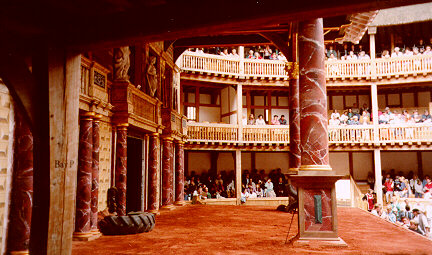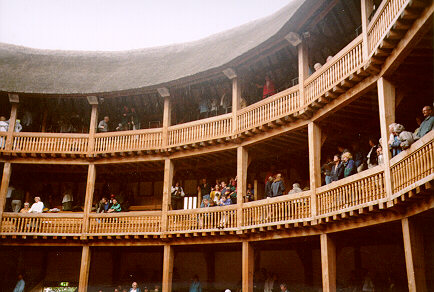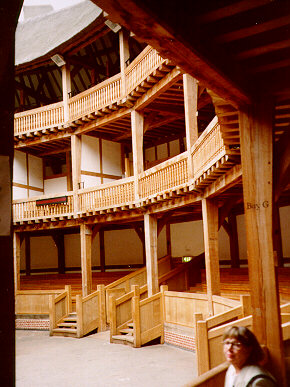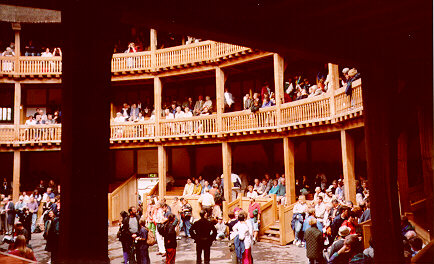|
The
Stage at the Globe

|
Here's the stage.
Impressive, huh? The design for the stage is based upon what scholars know
about staging in Elizabethan plays. There is the balcony, of course, which
occurs in so many of Shakespeare's plays. The painting on the underside
of the roof is called "the heavens" and represents the sky. There are three
entrance doors below and two above. The stage sits up about 5 feet off the
ground (notice the man standing in front) to allow the groundlings (pictures
below) to see what was going on (also to facilitate a trap door in the floor
of the stage). For more about the staging of Elizabethan plays, visit the
Globe's homepage. |
Side
View of the Stage

|
Here
is the stage from the side. This is where I sat for the performance of Winter's
Tale. It gave me a great view of the actors as well as the audience
and let me sit under shelter which, considering it was raining most of the
performance, was a good thing. It also let me watch the audience which was
interesting. As you can see this was not a traditional performance of Winter's
Tale (unless rubber tires were Elizabethan). The Globe does one traditional
performance a season. This means traditional everything right down to having
males portray the female characters. The other shows they do are more experimental.
The seats on either side of the stage on the second level are where the
Queen sat and are considered the best seats in the house (therefore the
most expensive), but I would argue that point. I liked being down closer
to the action. |
The
Gallery During Performance

|
Here you see the
gallery as it fills up for the performance. The Globe can seat 1500 people.
1000 of these are in the gallery seats and 500 can stand in the groundlings
section. Many of the people who were seated, however, came down to the groundlings
section for part of the play just to see what it was like. The seats are
strictly wooden benches, but if you get on the back row you can lean back.
Pillows to make the seats a bit more comfortable are available for a small
fee. The Globe is the first building in London to be built with a thatched
roof since the great fire of London in the 1600s. The thatch is sprayed
with fire retardant chemicals, as is the wood in the theatre, but otherwise
is just as it would have been in Shakespeare's day. |
The
Empty Gallery

|
Here is another
view of the Gallery before the crowds arrived. As you can see, it is three
levels high. All of the beams are made of oak and were assembled just as
they might have been in Shakespeare's day. No metal in sight. Some concessions
had to be made for modern day building codes but they have kept the space
as authentic as possible. Lighted exit signs, a sprinkler system (well camouflaged
I might add) and the incorporation of fire retardant material into the stucco
all had to be done. Otherwise, the space is eerily like stepping back in
time.
Eventually, the
groundling area, now just a concrete space sloping down to a drain to
keep rain water from pooling, will be covered with nutshells which apparently
graced the floor of Elizabethan theatres. Groundling seats are five pounds
(about $7.50) each and the gallery seats range from ten to twenty-five
pounds ($15 to $45). Still cheaper than a Broadway show by a long shot!.
Tours of the Theatre
are constantly in progress and include a tour of the exhibition area,
currently housed in what will be the Inigo Jones Theatre. When the exhibition
space under the Globe is complete, there will be a standing exhibition
about the original Globe and the construction of this new one.
|
The
Groundling Area

|
Here is a better
view of the groundling area. The performance I attended was not sold out
so some of the groundlings sat down. During the play, vendors wander around
selling food and drinks. This is in keeping with accounts of performances
from Elizabethan England. I suspect we pay more now than they did, but the
feel is still there. There is no artificial lighting during performances
which are all given during the day and early evenings. This means that the
actors are face to face with their audience at all times. This leads to
more actor/audience interaction than most of us are used to, but performances
are delightfully unpredictable. |




